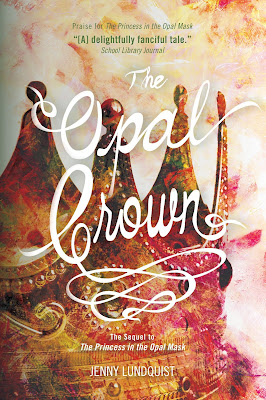Review: The Opal Crown
Last week, I reviewed an unnecessary sequel, so it only feels appropriate to follow up with another sequel I read that is so necessary that the original book feels empty without it. The Opal Crown by Jenny Lundquist fills in all of the gaps that were left behind by the Princess and the Pauper-inspired book, The Princess in the Opal Mask. I enjoyed The Princess in the Opal Mask, but was left with many questions after completing the final chapter. It leaves both girls in a delicate situation that is likely to fall apart at any moment. The Opal Crown conveys prcisely how that situation falls apart and how the girls must work together to save themselves, their kingdom, and choose how they will spend the rest of their lives. It is a fast-paced suspenseful adventure story that is superior to the original book in every way. This review will contain spoilers for The Princess in the Opal Mask, so be sure to read that first if it is a concern.
The Princess in the Opal Mask concludes with Princess Wilha choosing to give up her identity to her twin sister, Elara, who never got to experience the pleasures of royal life. In her final letter to Elara, Wilha claimed that she was going to "disappear" to give Elara the freedom and space she needed to be a true princess. This was a bit frustrating as a reader because Wilha had already built a new life for herself as a peasant and found a new family among the residents of a small village. It seemed like a shame for her to give all of that up when she worked so hard for it. In The Opal Crown, we learn that she did not stay true to her word to "disappear" and continues her position as a seamstress among her new friends at the inn. That is all well and good, but it causes problems for Elara, who married a prince under false pretenses and must wear Wilha's confining opal mask so that no one will notice she has a lookalike in town. It seems like an impossible situation. Anything that benefits one princess will harm the other.
The twins' new lives are interrupted early on when they are summoned back to their home kingdom by their brother, Andrei, who has been crowned king after the passing of their father. This creates a series of political schemes among the small handful of lords who are aware of the princesses' identities. Elara is taken into hiding, where one lord grooms her for a coup to steal the crown from her brother, while Wilha is brought to the castle where she must face the lord who attempted to murder her in the first book. Both princesses must find ways to communicate with each other to untangle the political schemes they are wrapped up in while trying to hide their connection from the wicked lord and the general public. In the process. Elara learns that she has a dark side that thirsts for power that she must learn to control, and Wilha realizes that she could do more good with the crown than she initially thought. They also attempt to speak to Andrei in secret to find out whether or not he is on their side and argue over how much of a role he plays in the kingdom's politics now that he is king.
The royal siblings have enough going on in their lives to have time to worry about romance. However, since the first book teased relationships for both girls that were left unresolved, this book helps to tie up some of those loose ends without spending a great deal of time on them. Elara finally comes clean to Prince Stefan about her true identity and must face the consequences for lying to him about who she was for the entirety of the first book. Wilha sorts out her feelings between the boy she met in the village and her swordsmanship trainer at the castle who she grew up with. It was nice to have some closure, but neither love story draws much attention away from the main plot of the book. At the end of the day, The Opal Crown is more about Elara learning to shed her gruff exterior and accept Wilha as the sister she never knew she had than it is about finding romantic love. Her relationship with her sister encompasses the true "happy ever after" of the book.
The Opal Crown should have been included as the second half of The Princess in the Opal Mask. The stories feel incomplete without each other, whereas together, they make a fantastic book. In a metaphorical sense, this is a good representation of the story's theme about how the sisters need each other to complete themselves. Elara is worldly and secretive, while Wilha is honest and humble. When the twins are united, they lend each other their strengths and become unstoppable. The Opal Crown is stronger overall due to faster pacing, sharper writing, and a more specific direction for the plot. I recommend reading both of these books in succession to fully grasp the author's vision.












Comments